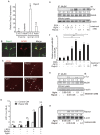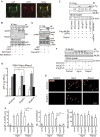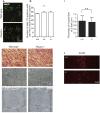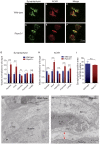R-spondin 2 promotes acetylcholine receptor clustering at the neuromuscular junction via Lgr5
- PMID: 27328992
- PMCID: PMC4916433
- DOI: 10.1038/srep28512
R-spondin 2 promotes acetylcholine receptor clustering at the neuromuscular junction via Lgr5
Abstract
At the neuromuscular junction (NMJ), acetylcholine receptor (AChR) clustering is mediated by spinal motor neuron (SMN)-derived agrin and its receptors on the muscle, the low-density lipoprotein receptor-related protein 4 (LRP4) and muscle-specific receptor tyrosine kinase (MuSK). Additionally, AChR clustering is mediated by the components of the Wnt pathway. Laser capture microdissection of SMNs revealed that a secreted activator of Wnt signaling, R-spondin 2 (Rspo2), is highly expressed in SMNs. We found that Rspo2 is enriched at the NMJ, and that Rspo2 induces MuSK phosphorylation and AChR clustering. Rspo2 requires Wnt ligands, but not agrin, for promoting AChR clustering in cultured myotubes. Leucine-rich repeat-containing G-protein coupled receptor 5 (Lgr5), an Rspo2 receptor, is also accumulated at the NMJ, and is associated with MuSK via LRP4. Lgr5 is required for Rspo2-mediated AChR clustering in myotubes. In Rspo2-knockout mice, the number and density of AChRs at the NMJ are reduced. The Rspo2-knockout diaphragm has an altered ultrastructure with widened synaptic clefts and sparse synaptic vesicles. Frequency of miniature endplate currents is markedly reduced in Rspo2-knockout mice. To conclude, we demonstrate that Rspo2 and its receptor Lgr5 are Wnt-dependent and agrin-independent regulators of AChR clustering at the NMJ.
Figures






Similar articles
-
Lack of Fgf18 causes abnormal clustering of motor nerve terminals at the neuromuscular junction with reduced acetylcholine receptor clusters.Sci Rep. 2018 Jan 11;8(1):434. doi: 10.1038/s41598-017-18753-5. Sci Rep. 2018. PMID: 29323161 Free PMC article.
-
Differential effects of spinal motor neuron-derived and skeletal muscle-derived Rspo2 on acetylcholine receptor clustering at the neuromuscular junction.Sci Rep. 2018 Sep 11;8(1):13577. doi: 10.1038/s41598-018-31949-7. Sci Rep. 2018. PMID: 30206360 Free PMC article.
-
Tyrosine phosphatases such as SHP-2 act in a balance with Src-family kinases in stabilization of postsynaptic clusters of acetylcholine receptors.BMC Neurosci. 2007 Jul 2;8:46. doi: 10.1186/1471-2202-8-46. BMC Neurosci. 2007. PMID: 17605785 Free PMC article.
-
Structural mechanisms of the agrin-LRP4-MuSK signaling pathway in neuromuscular junction differentiation.Cell Mol Life Sci. 2013 Sep;70(17):3077-88. doi: 10.1007/s00018-012-1209-9. Epub 2012 Nov 22. Cell Mol Life Sci. 2013. PMID: 23178848 Free PMC article. Review.
-
Roles of collagen Q in MuSK antibody-positive myasthenia gravis.Chem Biol Interact. 2016 Nov 25;259(Pt B):266-270. doi: 10.1016/j.cbi.2016.04.019. Epub 2016 Apr 24. Chem Biol Interact. 2016. PMID: 27119269 Review.
Cited by
-
Cell transcriptomic atlas of the non-human primate Macaca fascicularis.Nature. 2022 Apr;604(7907):723-731. doi: 10.1038/s41586-022-04587-3. Epub 2022 Apr 13. Nature. 2022. PMID: 35418686
-
Structure and Function of the Mammalian Neuromuscular Junction.Compr Physiol. 2022 Aug 11;12(4):3731-3766. doi: 10.1002/cphy.c210022. Compr Physiol. 2022. PMID: 35950651 Free PMC article.
-
Lack of Fgf18 causes abnormal clustering of motor nerve terminals at the neuromuscular junction with reduced acetylcholine receptor clusters.Sci Rep. 2018 Jan 11;8(1):434. doi: 10.1038/s41598-017-18753-5. Sci Rep. 2018. PMID: 29323161 Free PMC article.
-
Synaptic Homeostasis and Its Immunological Disturbance in Neuromuscular Junction Disorders.Int J Mol Sci. 2017 Apr 24;18(4):896. doi: 10.3390/ijms18040896. Int J Mol Sci. 2017. PMID: 28441759 Free PMC article. Review.
-
Neuropilin 1 regulates bone marrow vascular regeneration and hematopoietic reconstitution.Nat Commun. 2021 Nov 30;12(1):6990. doi: 10.1038/s41467-021-27263-y. Nat Commun. 2021. PMID: 34848712 Free PMC article.
References
-
- Burden S. J. SnapShot: Neuromuscular Junction. Cell 144, 826–826 e821 (2011). - PubMed
-
- Sanes J. R. & Lichtman J. W. Induction, assembly, maturation and maintenance of a postsynaptic apparatus. Nat Rev Neurosci 2, 791–805 (2001). - PubMed
-
- Bezakova G. & Ruegg M. A. New insights into the roles of agrin. Nat Rev Mol Cell Biol 4, 295–308 (2003). - PubMed
-
- McMahan U. J. et al.. Agrin isoforms and their role in synaptogenesis. Curr Opin Cell Biol 4, 869–874 (1992). - PubMed
Publication types
MeSH terms
Substances
LinkOut - more resources
Full Text Sources
Other Literature Sources
Molecular Biology Databases
Miscellaneous

